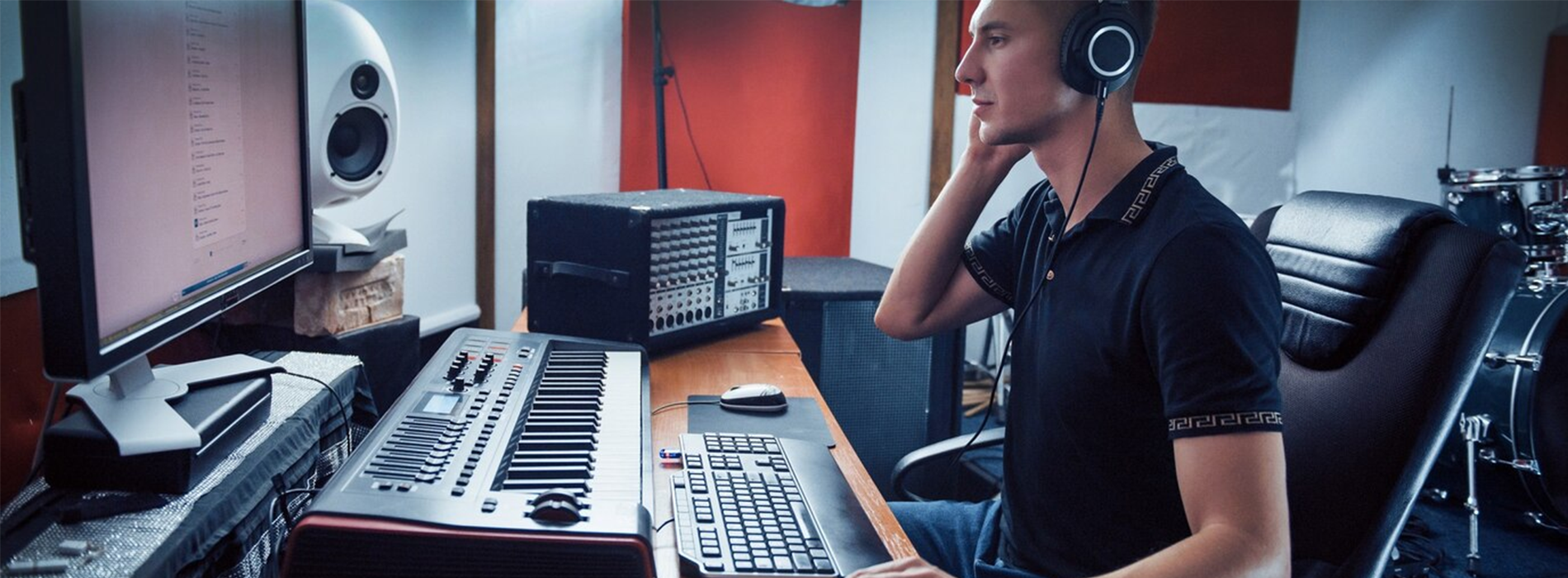In the realm of filmmaking, sound design emerges as a powerful yet often overlooked facet that significantly contributes to the overall impact of a movie. Just as visuals bring a story to life, sound design employs a symphony of auditory elements to immerse the audience in the narrative, emotions, and ambiance of a scene.
This blog delves into the multifaceted world of sound design, exploring its pivotal roles within the film industry and the vast scope it encompasses.
Table of Content
- What is Sound Design?
- Sound Designer Meaning
- What Does a Sound Designer Do?
- Applications Used in Sound Design
- Elements of Sound Design
- How to Become a Sound Designer?
- How to Make Unique Design
- Role of Sound Design in Music
- What is Sound Design in Film?
- Crafting Audio Effects for Sci-fi, Fantasy, and Horror Films
- Examples of Sound Design
- Sound Design Jobs
- Sound Design Software
- Sound Design vs. Sound Mixing – Key Differences
- Conclusion
- FAQs
- What is sound design and why is it important in media production?
- What tools and software are commonly used in sound design?
- Can I learn sound design without a formal degree?
- What’s the difference between sound design and sound editing?
- How do sound designers create effects for films, games, or music?
What is Sound Design?
Sound design is the intricate art of crafting immersive auditory experiences for various forms of media, from films and TV shows to podcasts and visual art. It involves skillfully combining elements like dialogue, music, sound effects, and ambient noise to create emotional resonance and enhance storytelling. Sound design extends beyond film to live theater, podcasts, commercials, and more, impacting how audiences perceive and connect with content. It’s a fusion of technical expertise and creative expression, molding sound into a powerful tool for evoking emotions and enriching narratives across diverse mediums.
Sound Designer Meaning
A sound designer is a professional who crafts and manipulates auditory elements, such as music, sound effects, and ambiance, to enhance storytelling and create immersive experiences in various media forms, including film, TV, theater, music, and more.
What Does a Sound Designer Do?
In the realm of film and TV production, a skilled sound designer takes on a pivotal role, intricately weaving auditory elements to create captivating sensory experiences. This professional collaborates within a project’s design team, alongside directors, production designers, and lighting experts, contributing their expertise to shape the auditory narrative. While dedicated composers handle the musical score, sound designers sculpt intricate soundscapes that immerse audiences into the heart of the story. A prime example lies in Star Wars, where John Williams composed the iconic score while sound designer Ben Burtt crafted the unique sounds of R2D2 and lightsabers.
A sound designer’s tasks encompass a diverse range of responsibilities:
- Recording: Sound designers often capture sounds for the production, whether through studio recordings or on-location field recordings. These raw audio elements serve as the building blocks for crafting immersive environments.
- Mixing: Sound designers engage in both studio and live mixing. In live theater, they might oversee the real-time audio mixing of music cues, sound effects, and actor microphones. For filmed entertainment, pre-mixed sound design palettes and cues are used during post-production.
- Sampling: Sampling involves recording individual sounds and programming them for triggered playback. For instance, a car horn could be sampled and triggered by a MIDI keyboard to replicate the sound precisely when needed.
- Effects Chains: Sound designers employ various effects like EQ, compression, reverb, and more to manipulate raw recordings, shaping them into the desired auditory experience.
- Sound Editing: Sound editing encompasses the entire process of manipulating audio, from splicing and manipulating recordings to creating sound effects and seamless transitions.
- Underscore: While composers handle musical scores in films, TV, and ads, sound designers in live theater and podcasting often contribute original underscore and incidental music. In filmed entertainment, a separate composer is typically involved in original music, along with a music supervisor to secure pre-recorded tracks.
Sound designers masterfully enhance narrative dynamics, infusing scenes with emotion, tension, and atmosphere. Their creative input transcends technicality, elevating stories to new levels of engagement and resonance by sculpting auditory worlds that resonate deeply with audiences.
Applications Used in Sound Design
Sound design’s impact resonates across various forms of art, but its significance is particularly pronounced in six distinct types of media, each drawing upon its unique characteristics to create captivating auditory experiences:
- Film: In the realm of film, the sound design weaves together sounds that mirror real-life scenarios. It breathes life into scenes, crafting intricate soundscapes that resonate with viewers’ emotions. From the gentle rustling of wind in a serene field to the clinking of glassware in a vintage diner, sound designers imbue each moment with authenticity. Although original underscore is usually composed by a separate artist, sound designers set the sonic stage for the narrative to unfold.
- Television: Similar to film, TV sound design is integral to the scene setting. The difference lies in the recurring nature of TV show locations. Sound designers create core templates that ensure consistency across episodes shot in the same locale, enhancing the overall viewing experience.
- Advertising: Sound designers play a subtle yet impactful role in advertising by crafting sonic palettes that complement various commercial worlds. These designs transport audiences to the envisioned environments without distraction, blending seamlessly with visuals to leave a lasting impression.
- Music: Sound design makes its mark even in music recordings, particularly within the avant-garde realm. Pioneering artists like Karlheinz Stockhausen and Steve Reich integrated field recordings and special effects into their compositions. Modern musicians like Brian Eno and Jim O’Rourke continue this tradition, combining sound effects with traditional instruments to create unique auditory tapestries.
- Podcasts: Podcasts hinge on sound-based storytelling, demanding meticulous sound design to transport listeners into vivid narrative realms. Whether creating immersive environments for narrative podcasts or crafting theme music for news shows, sound design is pivotal in establishing the mood and atmosphere of the story.
- Live Theater: Sound design’s role in live theater is multifaceted. It encompasses sound effects, pre-recorded voiceovers, and on-stage music sources like radios or televisions. Sound designers oversee real-time sound mixing and reinforcement, crucial for musical productions. Additionally, they contribute to the auditory landscape through incidental music, enhancing the theatrical experience at different junctures in the play.
Elements of Sound Design
Sound design is a complex craft that harmoniously weaves together various elements to create an immersive auditory experience. Within this intricate realm, six key elements stand out as fundamental components of sound design:
- Voice-over: Voice-over serves as a narrative tool or emanates from off-stage characters. The sound designer often records and edits voice-over audio, ensuring clarity and seamless integration within the production.
- Ambiance: Ambiance encompasses the rich sonic landscapes that transport audiences to different times and places. By incorporating real-life sounds, sound designers craft immersive settings, ranging from historical castles to modern train stations to futuristic spacecraft.
- Foley Sounds: Foley, a technique rooted in creating sound effects using physical objects, adds authenticity to auditory experiences. While modern sound designers often utilize digital libraries, some Foley artists continue to create tangible soundscapes for film, television, radio, and live theater.
- Audio Effects: Audio effects encompass specific sounds tied to objects or actions, like a ringing telephone or a roaring motorcycle. Whether designed from scratch or sourced from extensive libraries, these effects layer onto ambient soundscapes, enhancing realism and engagement.
- Music: Music is a cornerstone of sound design, involving both preexisting compositions and original works. It can emerge as sound heard by characters, such as music from a radio, or as underscore, enriching the audience’s emotional connection with the narrative.
- Live Microphones: In live theater productions, sound designers manage sound reinforcement, a crucial process involving microphones to amplify actors’ voices through the venue’s speakers. This might include live mixing by the designer or a dedicated soundboard operator.
How to Become a Sound Designer?
A well-rounded journey to success as a sound designer typically involves a combination of education and on-the-job training. Here are three key pathways that contribute to the development of sound designers:
Formal Institutional Training
Want to know how to learn sound design? While sound designers aren’t strictly required to hold degrees, formal training offered by theater or film schools can significantly enhance their skills and prospects. You can also pursue a sound design course. These educational institutions often have strong industry connections, providing students with opportunities to establish valuable contacts for their future careers. Through a structured music course and hands-on experience, students can gain a solid foundation in sound design principles and techniques.
Apprenticeship, On-The-Job Training, and Work-Study
Practical experience is invaluable for aspiring sound designers. Apprenticeships, on-the-job training, and work-study programs with small theater and film companies offer real-world exposure and hands-on learning. These opportunities allow individuals to apply their theoretical knowledge to actual productions, honing their skills while gaining insights into the industry’s inner workings.
Develop Your Vision
A crucial aspect of success as a sound designer is developing a clear artistic vision. Understanding what you want to achieve and the creative direction you wish to pursue can guide your career choices and projects. Whether your passion lies in film, theater, advertising, or other mediums, having a well-defined vision helps you set goals, make informed decisions, and shape your unique creative voice.
How to Make Unique Design
Creating a distinct audio experience is an art form in the world of sound design. Whether you are designing for films, games or digital materials, you can increase your production price by having a unique sound palette. Good sound design requires creativity, technical skills, and a deep understanding of the tools available through various sound design programs. These programs allow designers to shape, manipulate, and create the mood, tone and influence of a visual mood, tone and effects.
For beginners wondering what sound design is, it’s the process of creating audio elements for visual media. This is not only about background music, but it involves involving every sound description, from foot to atmospheric noise, ensuring that they originally mix in the story.
Role of Sound Design in Music
Sound designers play a crucial role in collaborating with musical artists to bring their creative visions to life. By skillfully manipulating the raw sounds of vocals and instruments, sound designers enhance the sonic quality and impact of musical compositions. This intricate process involves several key techniques:
- Sampling
- Digital sound creation
- Ordering effects in a vocal chain
- Sound editing and mixing
What is Sound Design in Film?
Sound design in films is the intentional creation and arrangement of auditory elements like dialogue, music, sound effects, and ambiance to enhance storytelling, create emotions, and immerse the audience in the cinematic experience. It adds depth, realism, and impact to scenes, making it a crucial aspect of filmmaking.
Crafting Audio Effects for Sci-fi, Fantasy, and Horror Films
Sound design for film plays a crucial role, especially in genres like sci-fi, fantasy, and horror. These films greatly trust the fictional world which requires reliable audio environment. For example, in a horror film, terrible surrounded sounds or sudden jumping intimidation is made by efficient sound designers to build stress specifically.
Using advanced sound design programs, designers can create alien spaceship noises, enchanted forest ambiences, or creepy whispers in haunted mansions. Without compelling sound design for film, even the most stunning visuals can feel empty. Therefore, sound designers must experiment with layering natural and synthetic sounds to craft these immersive audio effects.
Aspiring designers looking for sound designer jobs in India must develop such niche skills, as the Indian film and gaming industries are increasingly focusing on high-quality soundscapes.
Examples of Sound Design
Film – “Inception” (2010): The iconic film “Inception” directed by Christopher Nolan is a prime example of masterful sound design. The manipulation of sound effects, such as the slowing down of time during action sequences, and the interplay between reality and dreams is an essential component of the film’s mind-bending narrative.
Sound Design Jobs
Within the field of sound design, there are various job roles that contribute to different aspects of sound creation and manipulation. Here are some key job roles related to sound design:
- Sound Designer: Shapes overall soundscapes.
- Foley Artist: Creates realistic sound effects.
- Composer: Crafts original music.
- Sound Editor: Cleans, and synchronizes audio.
- Dialogue Editor: Ensures clear dialogue.
- Re-Recording Mixer: Balances all elements.
- Sound Effects Editor: Selects impactful effects.
- ADR Mixer: Adds seamless dialogue.
- Music Supervisor: Chooses fitting tracks.
- Boom Operator: Captures on-set audio.
Sound Design Software
Sound design software is an essential toolkit that empowers professionals to shape and manipulate auditory elements. Industry-standard programs like Pro Tools and Adobe Audition offer a wide range of tools and features, enabling sound designers to craft intricate soundscapes, enhance audio quality, and create immersive experiences. These software applications provide a platform for composing music, editing sound effects, synchronizing dialogue, and mixing audio elements with precision and creativity, amplifying the impact of storytelling in various media forms.
Sound Design vs. Sound Mixing – Key Differences
Many confuse sound design with sound mixing, but they serve different purposes in media production. The sound design focuses on creating and shaping the original sounds, while in the last output in the sound mixing, the final output involves balanced and adjusting audio levels to create everything together.
For example, a sound designer will produce a mythical creature roar, while a sound mixer will ensure that this Roar does not reinforce the character’s dialogue in one scene.Top of Form Both roles are essential in sound design for film, but they require different skill sets. Learning the distinction is part of most professional sound design programs.
Conclusion
Sound design plays a crucial role in films, games, and digital media, opening up various sound designer jobs in India across the growing entertainment and OTT sectors. Expanding into Music Production is also beneficial, as understanding music production enhances creative possibilities.
To master what is sound design and prepare for these opportunities, consider enrolling in professional sound design programs that build both technical and creative expertise.
FAQs
1. What is sound design and why is it important in media production?
Sound design includes creating original audio elements that raise the story in films, games and other media. It is important to set the mood and immerse the audience.
2. What tools and software are commonly used in sound design?
Popular sound design programs include Pro Tools, Logic Pro X and Abelton Live, which allow designers to manipulate and crafts in unique sounds.
3. Can I learn sound design without a formal degree?
Yes, many online courses teach sound designs, although structured programs provide better guidance to create a career in India and find sound designer jobs.
4. What’s the difference between sound design and sound editing?
Sound Design Involves Creating New Sounds, While Editing Arranges Existing Audio Clips. Both are important but serve different production stages.
5. How do sound designers create effects for films, games, or music?
Through techniques such as sampling, layering and synthesis using advanced equipment in sound design programs, professionals form an analog complex audio landscape to analog for various media.
























